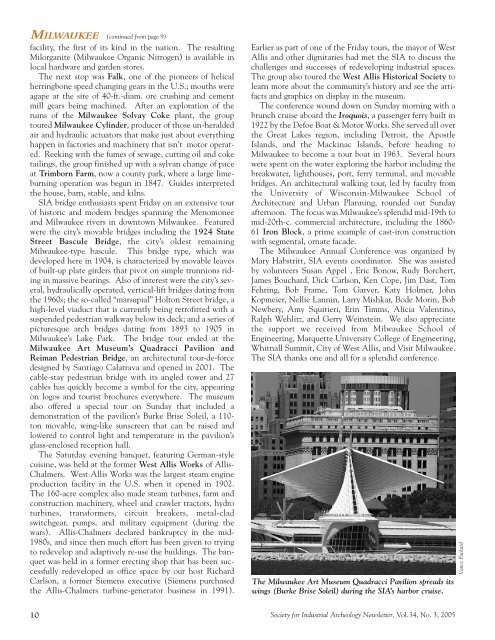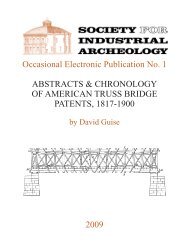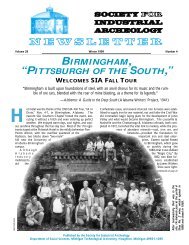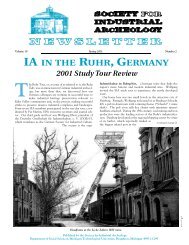SIAN - Society for Industrial Archeology
SIAN - Society for Industrial Archeology
SIAN - Society for Industrial Archeology
You also want an ePaper? Increase the reach of your titles
YUMPU automatically turns print PDFs into web optimized ePapers that Google loves.
MILWAUKEE (continued from page 9)<br />
facility, the first of its kind in the nation. The resulting<br />
Milorganite (Milwaukee Organic Nitrogen) is available in<br />
local hardware and garden stores.<br />
The next stop was Falk, one of the pioneers of helical<br />
herringbone speed changing gears in the U.S.; mouths were<br />
agape at the site of 40-ft.-diam. ore crushing and cement<br />
mill gears being machined. After an exploration of the<br />
ruins of the Milwaukee Solvay Coke plant, the group<br />
toured Milwaukee Cylinder, producer of those un-heralded<br />
air and hydraulic actuators that make just about everything<br />
happen in factories and machinery that isn’t motor operated.<br />
Reeking with the fumes of sewage, cutting oil and coke<br />
tailings, the group finished up with a sylvan change of pace<br />
at Trimborn Farm, now a county park, where a large limeburning<br />
operation was begun in 1847. Guides interpreted<br />
the house, barn, stable, and kilns.<br />
SIA bridge enthusiasts spent Friday on an extensive tour<br />
of historic and modern bridges spanning the Menomonee<br />
and Milwaukee rivers in downtown Milwaukee. Featured<br />
were the city’s movable bridges including the 1924 State<br />
Street Bascule Bridge, the city’s oldest remaining<br />
Milwaukee-type bascule. This bridge type, which was<br />
developed here in 1904, is characterized by movable leaves<br />
of built-up plate girders that pivot on simple trunnions riding<br />
in massive bearings. Also of interest were the city’s several,<br />
hydraulically operated, vertical-lift bridges dating from<br />
the 1960s; the so-called “marsupial” Holton Street bridge, a<br />
high-level viaduct that is currently being retrofitted with a<br />
suspended pedestrian walkway below its deck; and a series of<br />
picturesque arch bridges dating from 1893 to 1905 in<br />
Milwaukee’s Lake Park. The bridge tour ended at the<br />
Milwaukee Art Museum’s Quadracci Pavilion and<br />
Reiman Pedestrian Bridge, an architectural tour-de-<strong>for</strong>ce<br />
designed by Santiago Calatrava and opened in 2001. The<br />
cable-stay pedestrian bridge with its angled tower and 27<br />
cables has quickly become a symbol <strong>for</strong> the city, appearing<br />
on logos and tourist brochures everywhere. The museum<br />
also offered a special tour on Sunday that included a<br />
demonstration of the pavilion’s Burke Brise Soleil, a 110ton<br />
movable, wing-like sunscreen that can be raised and<br />
lowered to control light and temperature in the pavilion’s<br />
glass-enclosed reception hall.<br />
The Saturday evening banquet, featuring German-style<br />
cuisine, was held at the <strong>for</strong>mer West Allis Works of Allis-<br />
Chalmers. West Allis Works was the largest steam engine<br />
production facility in the U.S. when it opened in 1902.<br />
The 160-acre complex also made steam turbines, farm and<br />
construction machinery, wheel and crawler tractors, hydro<br />
turbines, trans<strong>for</strong>mers, circuit breakers, metal-clad<br />
switchgear, pumps, and military equipment (during the<br />
wars). Allis-Chalmers declared bankruptcy in the mid-<br />
1980s, and since then much ef<strong>for</strong>t has been given to trying<br />
to redevelop and adaptively re-use the buildings. The banquet<br />
was held in a <strong>for</strong>mer erecting shop that has been successfully<br />
redeveloped as office space by our host Richard<br />
Carlson, a <strong>for</strong>mer Siemens executive (Siemens purchased<br />
the Allis-Chalmers turbine-generator business in 1991).<br />
Earlier as part of one of the Friday tours, the mayor of West<br />
Allis and other dignitaries had met the SIA to discuss the<br />
challenges and successes of redeveloping industrial spaces.<br />
The group also toured the West Allis Historical <strong>Society</strong> to<br />
learn more about the community’s history and see the artifacts<br />
and graphics on display in the museum.<br />
The conference wound down on Sunday morning with a<br />
brunch cruise aboard the Iroquois, a passenger ferry built in<br />
1922 by the Defoe Boat & Motor Works. She served all over<br />
the Great Lakes region, including Detroit, the Apostle<br />
Islands, and the Mackinac Islands, be<strong>for</strong>e heading to<br />
Milwaukee to become a tour boat in 1963. Several hours<br />
were spent on the water exploring the harbor including the<br />
breakwater, lighthouses, port, ferry terminal, and movable<br />
bridges. An architectural walking tour, led by faculty from<br />
the University of Wisconsin-Milwaukee School of<br />
Architecture and Urban Planning, rounded out Sunday<br />
afternoon. The focus was Milwaukee’s splendid mid-19th to<br />
mid-20th-c. commercial architecture, including the 1860-<br />
61 Iron Block, a prime example of cast-iron construction<br />
with segmental, ornate facade.<br />
The Milwaukee Annual Conference was organized by<br />
Mary Habstritt, SIA events coordinator. She was assisted<br />
by volunteers Susan Appel , Eric Bonow, Rudy Borchert,<br />
James Bouchard, Dick Carlson, Ken Cope, Jim Dast, Tom<br />
Fehring, Bob Frame, Tom Garver, Katy Holmer, John<br />
Kopmeier, Nellie Lannin, Larry Mishkar, Bode Morin, Bob<br />
Newbery, Amy Squitieri, Erin Timms, Alicia Valentino,<br />
Ralph Wehlitz, and Gerry Weinstein. We also appreciate<br />
the support we received from Milwaukee School of<br />
Engineering, Marquette University College of Engineering,<br />
Whitnall Summit, City of West Allis, and Visit Milwaukee.<br />
The SIA thanks one and all <strong>for</strong> a splendid conference.<br />
The Milwaukee Art Museum Quadracci Pavilion spreads its<br />
wings (Burke Brise Soleil) during the SIA’s harbor cruise.<br />
10 <strong>Society</strong> <strong>for</strong> <strong>Industrial</strong> <strong>Archeology</strong> Newsletter, Vol.34, No. 3, 2005<br />
Vance Packard






